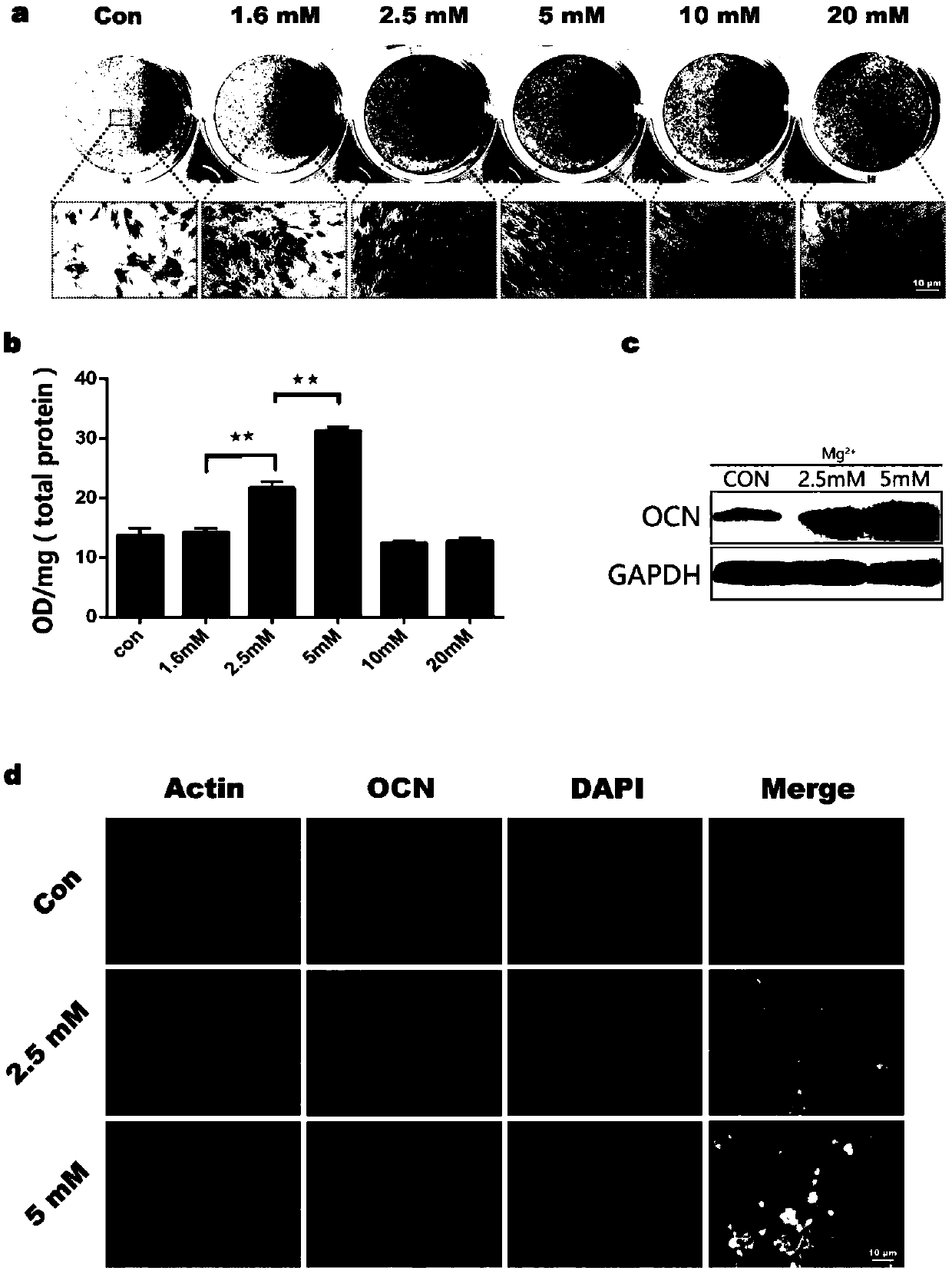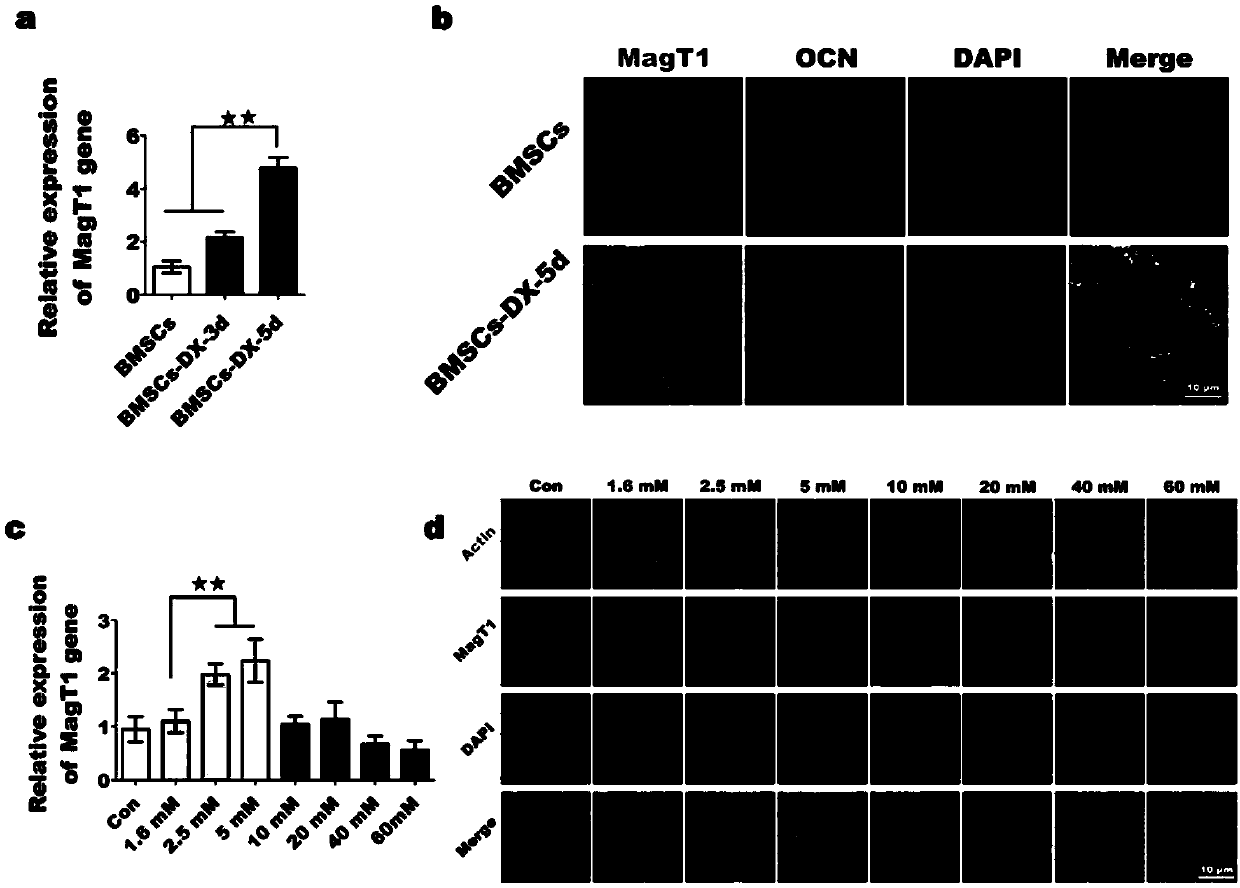High-magnesium microenvironment bone marrow stem cell microsphere carrier as well as preparation method and application thereof
A bone marrow stem cell and microenvironment technology, applied in prostheses, microcapsules, pharmaceutical formulations, etc., can solve problems that have not been reported in the literature, and achieve the effect of promoting bone defect repair and cell proliferation.
- Summary
- Abstract
- Description
- Claims
- Application Information
AI Technical Summary
Problems solved by technology
Method used
Image
Examples
Embodiment 1
[0029] Example 1. Detection of Magnesium Ion Toxicity to Rat Bone Marrow Stem Cells
[0030] Step 1. Isolation and culture of rat bone marrow stem cells
[0031] Sprague Dawley rats aged 3 to 4 weeks were killed by neck dislocation, and the dead bodies of the rats were disinfected by immersing them in 75% alcohol solution for 3 minutes. After the disinfection was completed, the bone marrow mesenchymal stem cells were obtained in the ultra-clean bench. Cut the skin at the groin of the rat, and bluntly dissect the tissue to expose the tibia and femur. Use scissors to cut off the knee joint, take out the tibia and femur, remove the muscle and other soft tissues on the bone surface, and cut off the epiphysis at both ends of the tibia; absorb an appropriate amount of DMEM complete culture solution with a syringe, insert the needle of the syringe into the bone marrow cavity, and use DMEM Pull up and down while washing the culture medium to ensure that the content of the bone marro...
Embodiment 2
[0034] Example 2. Magnesium ions affect the biological activity of cells
[0035] Step 1. Effect of different concentrations of magnesium ions on cell proliferation
[0036] According to the magnesium ion concentration screened in Example 1, configure the DMEM complete culture solution with magnesium ion concentration of 1.6, 2.5, 5, 10, 20mM respectively for subsequent use, take rat bone marrow stem cells, and inoculate them on a 96-well plate at a density of 1000 / well In medium (n=6), after the cells adhered to the wall, 100 μL of high-magnesium culture medium was replaced, and normal DMEM complete culture medium was used as the control group, and this time was recorded as day 0. On the 1st, 4th, and 7th day, add 10 μl MTT solution to each well, incubate for 4 hours, suck off the original liquid in the plate, add 150 μl DMSO to each well, and shake for 10 minutes to fully dissolve the crystals. The absorbance value was detected by a microplate reader to analyze the cell pro...
Embodiment 3
[0047] Example 3. Detection of changes in the expression of magnesium ion channel MagT1 in stem cells induced by different concentrations of magnesium ions
[0048] Step 1. Detection of MagT1 expression changes in stem cells after osteogenic induction
[0049] Rat bone marrow stem cells with a confluence of more than 90% were taken, digested and centrifuged, counted, inoculated in 6-well plates and confocal small dishes, and when the cell confluence reached 80%, the osteogenic induction medium (provided by Saiye Biotech) was replaced. At the same time, normal DMEM culture medium was used as a control (n=3) for osteogenesis induction. After 3 days and 5 days of induction, samples were collected for qPCR detection and immunofluorescence detection. The immunofluorescence staining method was the same as above; for qPCR samples, 1 mL of trizol was added to lyse the cells, and the total RNA of each group of samples was collected. Determine the concentration and purity of the extrac...
PUM
| Property | Measurement | Unit |
|---|---|---|
| size | aaaaa | aaaaa |
| diameter | aaaaa | aaaaa |
| diameter | aaaaa | aaaaa |
Abstract
Description
Claims
Application Information
 Login to View More
Login to View More - R&D
- Intellectual Property
- Life Sciences
- Materials
- Tech Scout
- Unparalleled Data Quality
- Higher Quality Content
- 60% Fewer Hallucinations
Browse by: Latest US Patents, China's latest patents, Technical Efficacy Thesaurus, Application Domain, Technology Topic, Popular Technical Reports.
© 2025 PatSnap. All rights reserved.Legal|Privacy policy|Modern Slavery Act Transparency Statement|Sitemap|About US| Contact US: help@patsnap.com



